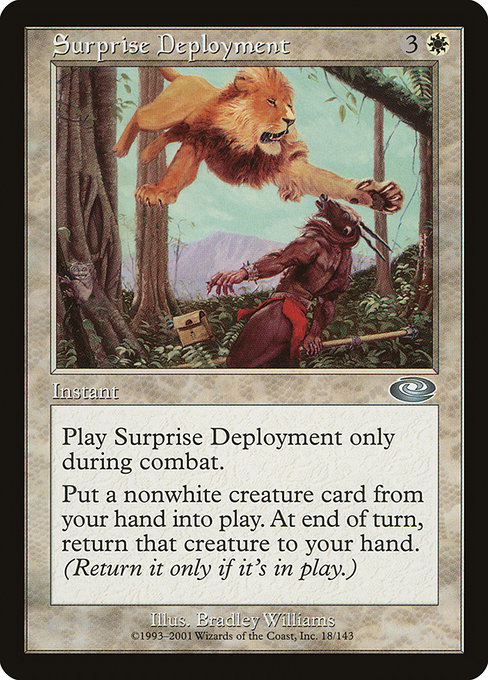
Image courtesy of Scryfall.com
Surprise Deployment: Print Runs Across MTG Expansions
If you’ve ever built a tempo-driven white strategy, Surprise Deployment feels like a pocket portal into a different era of MTG design 🧙♂️. This Instant from Planeshift (set code PLS) costs {3}{W} and tempts you to cast it only during combat. You may put a nonwhite creature card from your hand onto the battlefield, then at the beginning of the next end step, return that creature to your hand. It’s a clever tempo play that lets you flash in a bomb or a key attacker—only to bounce it back to your hand before the opponent can set up a cleaner answer. The white mana twist here is that you’re sacrificing nothing permanent on the battlefield in exchange for a moment of control, a tiny flourish of strategic irony that only early 2000s MTG could deliver with a straight face 💎⚔️.
From a print-frequency perspective, this card is a perfect case study. Planeshift, released in the dawn of the modern era (February 2001), sits in a time when Wizards of the Coast was still cementing where reprints commonly landed and how foil runs were balanced against nonfoil production. Surprise Deployment is listed as uncommon in its Planeshift printing, a rarity tier that typically signals a moderate print pool. It’s notable that the card’s official data shows it hasn’t been reprinted in a later set—this is evidenced by the lack of a reprint flag in the card’s standard data and the rarity ledger, which makes it a single-print card in the sense of modern reprint cycles. That single printing status, combined with its Commander-legal and Vintage-friendly legacy of use, has created a delicate balance of supply and desire among collectors and players alike 🧙♂️🔥.
Prices on Scryfall’s data snapshot offer a tiny window into the supply-and-demand dynamic of that era: approximately $0.24 for the nonfoil version and around $1.74 for the foil. Those numbers reflect an uncommon with enduring appeal but limited reprinting, which keeps foil scarcity relatively tame while elevating the nonfoil floor among budget-conscious players. It’s a microcosm of how print runs, rarity, and the card’s combat-flavored templating come together to shape both value and playability across decades. The Planeshift era was a friend to players who cherished efficient, tempo-oriented spells—cards that could tilt a single clash without requiring a long-term commitment, much like a well-timed cavalry charge in a skirmish line 💎🎲.
So how should a modern player think about print frequency when your objective is to track how often a card’s prints appear across expansions? Start with the basics: confirm the set, the rarity, and whether there are any reprint flags attached. Surprise Deployment’s data points—set: Planeshift, rarity: uncommon, and reprint: false—tell a story of a card that’s not slotted into later reprint cycles. When you widen the lens to the contemporary era, you see that print frequency is less about a single card and more about a family of spells that share white's tempo-based identity and combat-utility. In other words, early white tempo tricks like Surprise Deployment offer a taste of how Wizards balanced power, rarity, and supply in pre-modern reprint ecosystems 🧙♂️.
Beyond the numbers, the tactical texture of Surprise Deployment invites a particular nostalgia. Cast during combat, you cheat a nonwhite creature from hand onto the battlefield, then retrieve it at the end step—your opponent faced with a sudden push and then a prompt rebound. It’s the kind of design that rewards timing and deck-building precision, especially in formats where you’re allowed to stretch the tempo with temporary board presence. The flavor lines up with the white archetype of “deploy, retreat, and deploy again”—an echo of commanders who thrive on temporary forces, and a reminder that sometimes the shortest play creates the longest memory 🧨🎨.
How to track print frequency in practice
- Check the set and rarity: Start with Scryfall or Gatherer to confirm the card’s official set and rarity. Surprise Deployment is Planeshift’s uncommon—an indicator of moderate print runs within that era’s packaging philosophy.
- Review reprint history: Look for any official reprint announcements or card-printing databases. A lack of reprint flags typically signals a single primary printing, which influences long-term availability and price stability.
- Assess foil vs nonfoil counts: Foil versions, where available, tend to be scarcer and command higher prices, even for uncommon cards. The price delta on Surprise Deployment aligns with that dynamic.
- Consider format demand: Commander legality and legacy viability often drive interest. Surprise Deployment is legacy-legal and Vintage-legal, which helps sustain a niche but loyal demand across formats despite its uncommon rarity.
- Correlate with collector activity: Use price trends, print runs (as tracked by databases), and market chatter to gauge how supply constraints or surges might reflect printing history across expansions.
And if you’re browsing this MTG journey while sipping on your favorite analog-dice-and-deck pastime, you might want a comfortable workstation for long drafting nights or tournament weekends. This is where a trusty mouse pad becomes your unsung sidekick. That’s where our product fits in—a practical companion for those steadily-paced queues of games and brainstorms, whether you’re drafting white tempo or curating a surprise deployment-esque draw-engine deck. For fans who appreciate a tactile reminder of a classic era, the combination of nostalgia and utility is a small but meaningful victory 🧙♂️🔥.
For readers who want to explore more about the broader magic of collecting, there’s a curated network of thoughts and essays on print density, rarity, and deck-building culture. Dive into these five pieces for diverse perspectives on how print runs shape the MTG landscape:
Gaming Mouse Pad 9x7 Neoprene with Stitched EdgesMore from our network
- https://blog.zero-static.xyz/blog/post/balancing-fun-and-competition-with-nutrient-block/
- https://blog.digital-vault.xyz/blog/post/goblin-war-paint-and-graveyard-recursion-a-red-strategy/
- https://crypto-acolytes.xyz/blog/post/exploring-minecrafts-historical-builds-cities-castles-wonders/
- https://blog.digital-vault.xyz/blog/post/designing-procreate-brush-packs-for-illustrators/
- https://blog.digital-vault.xyz/blog/post/why-mundungus-rarity-drives-mtg-collectors/